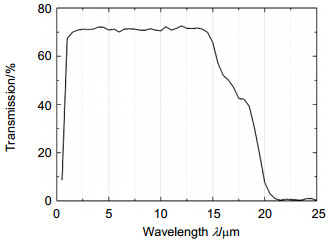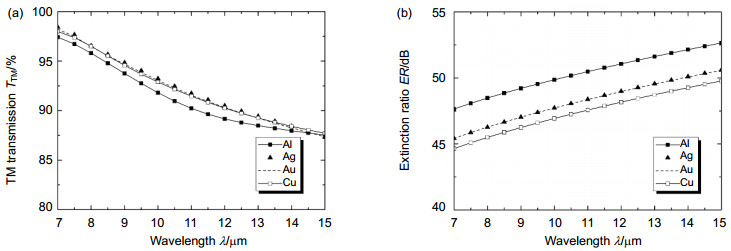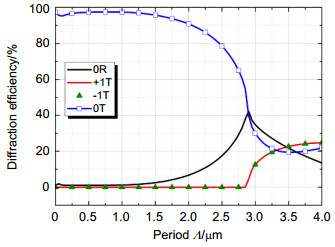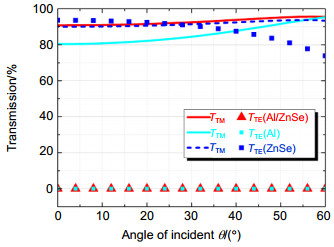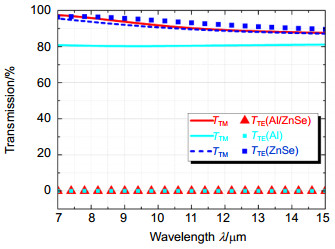Design of long-wavelength infrared polarizer based on sub-wavelength aluminum-ZnSe grating
-
摘要
为提高长波红外偏振成像系统中偏振器件性能,本文通过分析光栅材料及结构参数对光栅偏振性能的影响,设计并优化了一种双层材料构成的亚波长光栅。该光栅为矩形形貌,光栅区由铝与硒化锌构成,两种材料的厚度分别为0.6 μm和0.4 μm,光栅周期1 μm,占空比50%。利用严格耦合波理论分析并计算该结构光栅的衍射效率,7~15 μm波段的光以0~60°入射后其0级横磁模透射率达到87.54%以上,消光比超过47 dB。该光栅在10.6 μm的测试波长下,TM透射率高达90.80%且具有50 dB以上的消光比,相比槽深相同的单层铝光栅,偏振透过率明显提高。仿真结果显示,该光栅在整个宽长波红外波段具有良好的偏振性能。

Abstract
A dual-layered sub-wavelength grating consisting of two kinds of materials, aluminum and ZnSe, is developed to improve the performance of polarimetric elements in long-wavelength infrared (LWIR) polarization imaging system. Parameters of the designed grating's morphological structure are optimized on the basis of analyzing the effects on the polarization performance through the rigorous coupled wave theory, which helpfully calculates the diffraction efficiency. With a rectangular profile, the grating designed for applications in LWIR band has periods of 1 μm and 50%-fill-factor. The depths of aluminum and ZnSe in the grating region are 0.6 μm and 0.4 μm respectively. A TM transmission greater than 87.54% with an extinction ratio exceeding 47 dB is achieved in the 7~15 μm band when the angle of incidence is from zero to sixty degree. The grating maintains an extinction ratio better than 50 dB and TM transmission over 90.80% above 10.6 μm incident wavelength, which is superior to single-layered aluminum gratings with the same depth in the transmission performance in comparison. The simulation results show that this grating has excellent polarization performance in the broad LWIR band.
-
Overview

Abstract: Polarization measurement is able to effectively solve the problems that are beyond the reach of conventional photometry. When it comes to long-wavelength infrared (LWIR) polarization imaging system, polarization device plays a vital role in measuring the targets’ radiation and reflection and distinguishing them from busy background, which compensates for the lack of traditional thermal imaging if the difference in temperature is unobservable. Sub-wavelength wire-grid polarizer (WGP) is characterized by small volume and compact structure with the micro- or nano-manufacturing technology. It is a grating structure whose period is smaller than the incident wavelength and when that is smaller than the critical one, the grating will only have zero-ordered diffraction, which helps improve the utilization ratio of polarization information. A dual-layered sub-wavelength grating consisting of two kinds of materials, aluminum and ZnSe, is developed to improve the performance of polarimetric elements in LWIR polarization imaging system. Parameters of the designed grating’s morphological structure are optimized on the basis of analyzing the effects on the polarization performances through the rigorous coupled wave theory, which helps describe the diffraction of electromagnetic waves by periodic grating structures and calculate diffractive efficiencies of different orders. With a rectangular profile, the grating designed for applications in LWIR band has a structure of 1μm-period and 50%-fill-factor. The depths of aluminum and ZnSe in the grating region are 0.6 μm and 0.4 μm respectively. A TM transmission greater than 87.54% with an extinction ratio exceeding 47 dB is achieved in the 7 μm ~15 μm band when the angle of incidence is from zero to sixty degree. The grating maintains an extinction ratio better than 50 dB and TM transmission over 90.80% above 10.6 μm incident wavelength, which is superior to single-layered aluminum gratings with the same depth in the transmission performance in comparison. The structure is featured for the excessive etching on substrate, resulting in a series of air grooves. Therefore, the dielectric grating layer beneath the metal wire grid is formed. This method for improving polarization performances is easier to implement than coating anti-reflective films. It is investigated that the TM transmission increases with the depths of both metal and dielectric layers when the extinction ratio is dominated by the depth of metal layer, while the single-layered ZnSe grating shows little potential in extinction ability for the lack of metal component. Compared with the existed designs of WGP, the simulation results show that the TM transmission and extinction ratio are effectively improved in broad LWIR band with the proposed structure. Besides, the angle-tolerance indicates that the design has great capability in applications with wide field angle.
-

-
表 1 不同槽深对偏振性能的影响结果.
Table 1. Results of polarization performances in different layer depths.
h1/μm h2/μm TTM /% ER/dB 0.4 0.2 87.62 29 0.6 0.4 92.84 41 0.4 0.4 89.57 40 0.8 0.2 92.85 31 0.4 0.6 90.80 50 0.8 0.4 95.62 41 0.6 0.2 90.26 30 0.9 0.8 98.64 62 表 2 不同光栅结构的线栅偏振器性能比较.
Table 2. Performances comparison of WGP with different structures.
-
参考文献
[1] Yemelyanov K M, Lin S S, Luis W Q, et al. Bio-inspired display of polarization information using selected visual cues[J]. Proceedings of the SPIE, 2003, 5158: 71‒84. doi: 10.1117/12.506084
[2] Lin S S, Yemelyanov K M, Pugh E N, et al. Polarization en-hanced visual surveillance techniques[C]// IEEE International Conference on Networking, Sensing and Control, 2004, 1: 216‒221.
https://ieeexplore.ieee.org/document/1297437/ [3] Gartley M G. Polarimetric modeling of remotely sensed scenes in the thermal infrared[D]. Rochester: Rochester Institute of Technology, 2007.
http://scholarworks.rit.edu/cgi/viewcontent.cgi?article=9247&=&context=theses&=&sei-redir=1&referer=http%253A%252F%252Fcn.bing.com%252Fsearch%253Fq%253DPolarimetric%252Bmodeling%252Bof%252Bremotely%252Bsensed%252Bscenes%252Bin%252Bthe%252Bthermal%252Binf%2526qs%253Dn%2526form%253DQBRE%2526sp%253D-1%2526pq%253Dpolarimetric%252Bmodeling%252Bof%252Bremotely%252Bsensed%252Bscenes%252Bin%252Bthe%252Bthermal%252Binf%2526sc%253D0-66%2526sk%253D%2526cvid%253DACDC179B6E6248A5A1A939734A7F325B#search=%22Polarimetric%20modeling%20remotely%20sensed%20scenes%20thermal%20inf%22 [4] 张娜, 褚金奎, 赵开春, 等.基于严格耦合波理论的亚波长金属光栅偏振器设计[J].传感技术学报, 2006, 19(5): 1739‒1743. http://d.wanfangdata.com.cn/Periodical_cgjsxb200605113.aspx
Zhang Na, Chu Jinkui, Zhao Kaichun, et al. The design of the subwavelength wire-grid polarizers based on rigorous cou-ple-wave theory[J]. Chinese Journal of Sensors and Actuators, 2006, 19(5): 1739‒1743. http://d.wanfangdata.com.cn/Periodical_cgjsxb200605113.aspx
[5] 孟凡涛, 褚金奎, 韩志涛, 等.亚波长金属光栅偏振器设计[J].纳米技术与精密工程, 2007, 5(4): 269‒272. http://kns.cnki.net/KCMS/detail/detail.aspx?filename=nmjm200704010&dbname=CJFD&dbcode=CJFQ
Meng Fantao, Chu Jinkui, Han Zhitao, et al. Design of the sub-wavelength wire-grid polarizers[J]. Nanotechnology and Precision Engineering, 2007, 5(4): 269‒272. http://kns.cnki.net/KCMS/detail/detail.aspx?filename=nmjm200704010&dbname=CJFD&dbcode=CJFQ
[6] Chen C M, Niu Peilun, Sung C K, et al. Fabricating bi-layered metallic wire-grid polarizers by nanoimprint and O2 plasma etching[J]. Microelectronic Engineering, 2013, 102: 53‒59. doi: 10.1016/j.mee.2012.05.025
[7] 周阳. 全息深亚波长光栅技术研究[D]. 苏州: 苏州大学, 2015.
Zhou Yang. The research of deep-subwavelength grating by holographic-immersion lithography[D]. Suzhou: Soochow Uni-versity, 2015.
http://cdmd.cnki.com.cn/Article/CDMD-10285-1015406116.htm [8] 廖艳林, 韩正甫, 曹卓良.亚波长金属/电介质双层光栅偏振片[J].中国科学技术大学学报, 2005, 35(5): 650‒655. http://kns.cnki.net/KCMS/detail/detail.aspx?filename=zkjd200505012&dbname=CJFD&dbcode=CJFQ
Liao Yanlin, Han Zhengfu, Cao Zhuoliang. Polarizer based on double layer subwavelength metal dielectric grating structure[J]. Journal of University of Science and Technology of China, 2005, 35(5): 650‒655. http://kns.cnki.net/KCMS/detail/detail.aspx?filename=zkjd200505012&dbname=CJFD&dbcode=CJFQ
[9] 李以贵, 杉山进.基于X光光刻的亚波长光栅[J].纳米技术与精密工程, 2007, 5(4): 249‒252. http://kns.cnki.net/KCMS/detail/detail.aspx?filename=nmjm200704005&dbname=CJFD&dbcode=CJFQ
Li Yigui, Sugiyama S. Sub-wavelength gratings based on X-ray lithography[J]. Nanotechnology and Precision Engineering, 2007, 5(4): 249‒252. http://kns.cnki.net/KCMS/detail/detail.aspx?filename=nmjm200704005&dbname=CJFD&dbcode=CJFQ
[10] Ebbesen T W, Lezec H J, Ghaemi H F, et al. Extraordinary optical transmission through sub-wavelength hole arrays[J]. Nature, 1998, 391(6668): 667‒669. doi: 10.1038/35570
[11] Brundrett D L, Glytsis E N, Gaylord T K. Homogeneous layer models for high-spatial-frequency dielectric surface-relief grat-ings: conical diffraction and antireflection designs[J]. Applied Optics, 1994, 33(13): 2695‒2706. doi: 10.1364/AO.33.002695
[12] 郭庆. 金属光栅偏振器设计及其工艺仿真[D]. 大连: 大连理工大学, 2009.
Guo Qing. The designing and fabrication process simulation of the wire-grid polarizer[D]. Dalian: Dalian University of Technol-ogy, 2009.
http://cdmd.cnki.com.cn/Article/CDMD-10141-2010020627.htm [13] Moharam M G, Pommet D A, Grann E B, et al. Stable imple-mentation of the rigorous coupled-wave analysis for sur-face-relief gratings: enhanced transmittance matrix approach[J]. Journal of the Optical Society of America A, 1995, 12(5): 1077‒1086. doi: 10.1364/JOSAA.12.001077
[14] 康果果, 谭峤峰, 陈伟力, 等.亚波长金属线栅的设计、制备及偏振成像实验研究[J].物理学报, 2011, 60(1): 337‒343. http://wuxizazhi.cnki.net/Sub/jcwl/a/WLXB201101052.html
Kang Guoguo, Tan Qiaofeng, Chen Weili, et al. Design and fabrication of sub-wavelength metal wire-grid and its application to experimental study of polarimetric imaging[J]. Acta Physica Sinica, 2011, 60(1): 337‒343. http://wuxizazhi.cnki.net/Sub/jcwl/a/WLXB201101052.html
[15] 张亮, 李承芳. 150 nm亚波长铝光栅的近红外偏振特性[J].中国激光, 2006, 33(4): 467‒471. https://www.wenkuxiazai.com/doc/b4029a2ca26925c52dc5bf0a.html
Zhang Liang, Li Chengfang. Polarization effect of 150nm subwavelength aluminum wire grating in near infrared[J]. Chi-nese Journal of Lasers, 2006, 33(4): 467‒471. https://www.wenkuxiazai.com/doc/b4029a2ca26925c52dc5bf0a.html
[16] Hasman E, Bomzon Z, Niv A, et al. Polarization beam-splitters and optical switches based on space-variant comput-er-generated subwavelength quasi-periodic structures[J]. Optics Communications, 2002, 209(1-3): 45‒54. doi: 10.1016/S0030-4018(02)01598-5
[17] 周传宏, 王磊, 聂娅, 等.介质光栅导模共振耦合波分析[J].物理学报, 2002, 51(1): 68‒73. doi: 10.7498/aps.51.68
Zhou Chuanhong, Wang Lei, Nie Ya, et al. The rigorous coupled-wave analysis of guided-mode resonance in dielectric gratings[J]. Acta Physica Sinica, 2002, 51(1): 68‒73. doi: 10.7498/aps.51.68
[18] 曾海芳. 红外偏振成像的关键技术研究[D]. 南京: 南京理工大学, 2012.
http://cdmd.cnki.com.cn/Article/CDMD-10288-1012320221.htm [19] 卓丽霞. 亚波长金属光栅结构的红外特性研究[D]. 成都: 电子科技大学, 2011.
http://cdmd.cnki.com.cn/Article/CDMD-10614-1011194236.htm -
访问统计


 E-mail Alert
E-mail Alert RSS
RSS

 下载:
下载:
